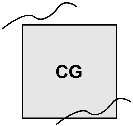|
5.A.vii. Digital Chart of the World
* Primary reference citation for all data from this source ** Primary reference citation for Digital Chart of the World Digital Chart of the World (DCW) is a vector cartographic data set based largely on the 1:1,000,000-scale Operational Navigation Chart (ONC) series of aircraft navigation charts. ONC has been cited as the largest scale base map source with global coverage (Danko, 1992). ONCs were products of the Army Mapping Service (AMS), then DMA, now National Imagery and Mapping Agency (NIMA). They were based on photogrammetric analyses of Department of Defense Corona imagery acquired in the 1960s. ONCs contain vector base map information such as political boundaries, transportation infrastructure, waterways, and coastlines, as well as raster-like shading for selected categories of land cover type. The objective of this information is to facilitate navigation by pilots. In addition, for much (but not all) of the world, ONCs contain topographic contours. The primary contour interval is 1000ft (305m), with supplemental contours at 250ft (76m) intervals in areas below 1000ft elevations. Limited supplemental contours at 500ft (152m) intervals exist above 1000ft elevations. Point elevations also appear in ONCs, often at airports, cities, or topographic features such as selected mountain peaks. In addition, some lake surfaces are labeled with typical elevations. In many areas lacking topographic contours, sparse point elevations are still available. ONCs (and DCW, which is derived from ONCs) use World Geodetic System 84 (WGS84) for horizontal reference, and Mean Sea Level as vertical reference. However, this may not always be the case, as cartographic sources (for example) may not be completely or accurately described, and materials from such sources may not be accurately converted to WGS84 and Mean Sea Level. In the late 1980s, DMA instigated a design and contracting process to digitize the contents of ONCs. The work was contracted to a private company. The resultant data base occupies four CD-ROMs, which is distributed by USGS for DMA. Absolute horizontal accuracy of the DCW hypsography is reported to be 2040m rounded to the nearest 5m at 90% circular error. Vertical accuracy is considered to be 610m for contours, and 30m for spot elevations (DMA, 1990). Errors can exceed such figures locally. For example, the ONC for northern Greenland contains notices such as: "CAUTION: Arctic Institute of North America Project Nord (Control Data Corp.) indicates position discrepancies in excess of 11 nautical miles (Nov. 68)." Topographic contours and point elevations are the primary data for deriving DEMs from DCW. Supplementary data include drainage information. Streams were used to guide the contour-to-grid process using the ANUDEM program of Hutchinson (1989, 1996). Lake shorelines and ocean coastlines provide further guidance. DCW was used as the primary source for filling gaps in the DTED coverage, including all of the unrestricted DEM for Australia, and large areas of Africa, South America, and Canada. University College London was active in early development of DCW conversion techniques; the Jet Propulsion Laboratory used contour-to-grid techniques to make much of its 30" DEM noted in Section 1 and in Section 5.A.vi. However, all of DCW contour-to-grid data used in GLOBE were produced by USGS. The following is USGS, 1997b, description of its vector data processing techniques. These apply to DCW, as well as the other cartographic source materials listed in Sections 5.A.viii, 5.A.ix, 5.A.x., and 5.A.xi: "The topographic information from the vector cartographic sources, including the DCW, the ADD [Antarctic Digital Database], and the Army Map Service, International Map of the World, and Peru 1:1,000,000-scale maps, was converted into elevation grids through a vector-to-raster gridding approach. Contours, spot heights, stream lines, lake shorelines, and ocean coastlines were input to the ANUDEM surface gridding program developed at the Australian National University (Hutchinson, 1989). ANUDEM, specifically designed for creating DEM’s sic from digital contour, spot height, and stream line data, employs an approach known as drainage enforcement to produce raster elevation models that represent more closely the actual terrain surface and contain fewer artifacts than those produced with more general purpose surface interpolation routines. Drainage enforcement was performed for all areas covered by vector source data except Antarctica and Greenland. The following passage is from another part of USGS (1997b): "Prior to merging with the generalized raster data, lakes for which the DCW did not indicate an elevation were updated on the DCW grid with the lowest grid cell elevation found along the shoreline. When each of the vector sources was gridded, an overlap area with the adjacent raster sources was included so that smoothing could be performed to minimize the elevation discrepancies among the sources. Also, additional point control was input into the ANUDEM gridding process so interpolated elevations in the overlap region would more closely match the raster source elevations. The additional control was derived from the generalized raster sources within a 1-degree buffer surrounding the vector source areas."
Analysis of Histograms: As the Digital Chart of the World was the source for about 23% of GLOBE, we performed histogram analyses on DEMs from DCW for the same areas as NIMA discrete data. Note that only data used in GLOBE were run through the histogramming process, so DTED- and DCW-based histograms should be different:
|
| All Bathy/Relief | Coastal DEMs | Fishing | Global | Lakes | Multibeam | NOS |







